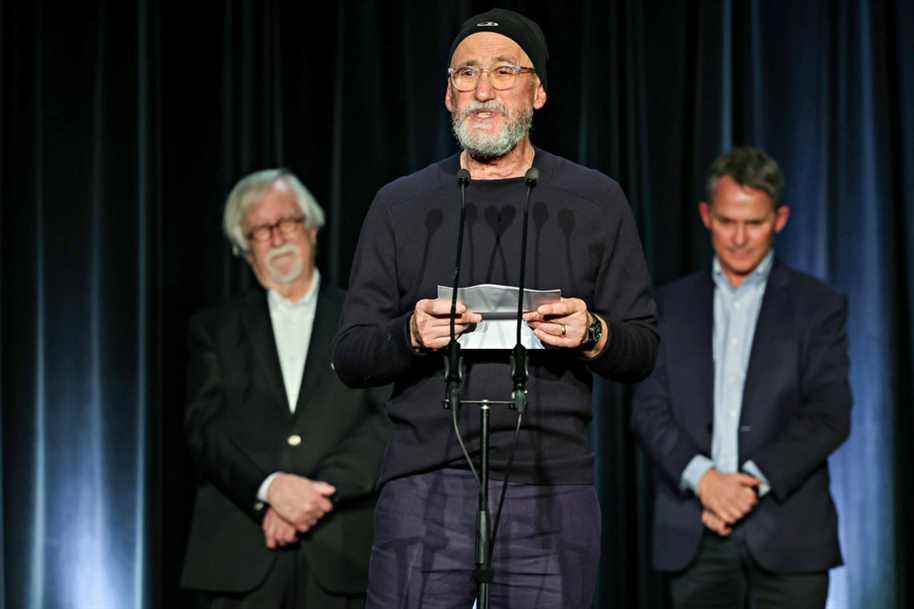“I am happy, very happy, because I did not see this prize coming, since we are not applying for the Ozias-Luduc prize,” said the 68-year-old artist. It’s a great recognition that comes at a good time. A price that I know well. I have enormous respect for the people who have had it. ”
Created in 1992, the Ozias-Leduc Prize has already been awarded to artists Roland Poulin, Jana Sterbak, Rober Racine, Massimo Guerrera, Guy Pellerin, Serge Murphy, Raymond Gervais, Marie-Claude Bouthillier and Valérie Blass.
The jury for this edition was chaired by Stéphane Aquin, Director General of the Montreal Museum of Fine Arts, who underlined François Morelli’s “sense of commitment” during his career. The other members of the jury were Anne-Claude Bacon, responsible for the Hydro-Québec collection, Jonathan Demers, director general of the Musée d’art contemporain des Laurentides, the artist Serge Murphy and Bénédicte Ramade, curator and lecturer at the Montreal university.
François Morelli has already been awarded the Prix d’Excellence de la Biennale de dessin, de l’Estampe et du papier du Québec, in 1993, and the Louis-Comtois Prize, in 2007. In his speech, he paid tribute to to gallery owners who have regularly disseminated his work. Christine Chassay and Joyce Yahouda, in Montreal, Stuart Horodner, in New York. He also thanked Isabelle de Mévius, the patron and director of the 1700 La Poste art center, who organized a beautiful retrospective for him in 2017.

PHOTO FRANÇOIS ROY, THE PRESS
Multidisciplinary artist François Morelli.
“I never missed an opportunity to show what I was doing,” he said. I am also deeply grateful to the curators, directors, art historians and art critics who have examined my work. If it takes a village to raise a child, it takes a strong community to make an artist. He thus thanked his teachers who made him an artist and a teacher at heart. Over 35 years working in universities: Concordia, Université du Québec à Trois-Rivières and Rutgers, New Jersey.
Teaching is at the heart of my artistic practice, never in parallel or alongside. It is a fulfillment.
Francois Morelli
A graduate in visual arts from Concordia and Rutgers, François Morelli is interested in figures, space, what defines them (clothing, furniture and architecture), physical, psychic and social conventions and the multitude of behaviors and strategies of existence and resistance.
“I pursue a versatile approach – in drawing, print, installation, performance and sculpture – marked by a sustained questioning as to the status of the object within the processes of creation and the perception of the work,” explains -he. I am interested in the notions of passage, circulation and transformation. For me, the work often echoes a past action or an intervention aimed at translating, not only in space, but also in time, the artist’s relationship with society, individuals among themselves, or of the individual with the object. ”
Drawings from Carnet Volume XXIII (2020) – ink on paper.
-

PHOTO PROVIDED BY THE ARTIST
-

PHOTO PROVIDED BY THE ARTIST
-

PHOTO PROVIDED BY THE ARTIST
-

PHOTO PROVIDED BY THE ARTIST
-

PHOTO PROVIDED BY THE ARTIST
-

PHOTO PROVIDED BY THE ARTIST
1/ 6
François Morelli has not been idle in recent years, especially during confinement. The dining room of his residence in Notre-Dame-de-Grâce had become his studio. There he created a frieze on Arches paper of 35 leaves and another series of drawings linked to his sculptures of metallic threads.
“They are figures who desperately seek to communicate and to give meaning to their lives,” he says. Come to think of it, much like Beckett in our new COVID reality. I am convinced that this period of confinement allowed me, with hindsight, to revisit myself and better understand my excesses. This work completely changed my working habits. Diurnal by nature, I turned into a nocturnal beast, waking up at all hours of the night to draw until the wee hours of the morning. ”
-

PHOTO PROVIDED BY THE ARTIST
Performance by François Morelli in 2020 in the waters of the St. Lawrence, near the park of the Maison du Citoy de Pointe-aux-Trembles, as part of the resuscitation of four sculptures from 1990 exhibited in Dorval and Pointe-aux-Trembles.
-

PHOTO PROVIDED BY THE ARTIST
Artist Bonnie Baxter invited François Morelli to participate in a project in Val-David at her home last year.
1/ 2
Since the deconfinement, François Morelli has alternated work between his studio on rue Montgomery and his house in Val-David, where he goes with his wife for more than 50 years, Diane Charbonneau, former head of the decorative arts department at the Museum. des beaux-arts de Montréal, and to whom he paid tribute. “We are a fine team, strong in a mutual respect where life and love are a work of art,” he told her.
Exhibition at the Maison des arts de Laval in 2019
-

PHOTO PROVIDED BY THE ARTIST
Collective exhibition Thousand sheets. When the drawing takes place. Curator: Lise Lamarche.
-

PHOTO PROVIDED BY THE ARTIST
Collective exhibition Thousand sheets. When the drawing takes place.
-

PHOTO PROVIDED BY THE ARTIST
Exposure Thousand sheets. When the drawing takes place.
1/ 3
François Morelli has many projects in the works. One part will be completed in 2022. In this period of pandemic, he believes that the challenges are enormous and that the questions underlying his work remain current and more powerful than ever.
“How to draw a landscape in our geological era known as Anthropocene when the ecosystems of the planet are in the process of profound change or disappearance because of the repercussions of our activities? How can we take a portrait when we have difficulty recognizing the other in ourselves and vice versa? How do you represent history when you can’t find your way around and the future is more and more uncertain? Finally, what is the use of form when it excludes us and only speaks for itself. Long live the living art! ”

